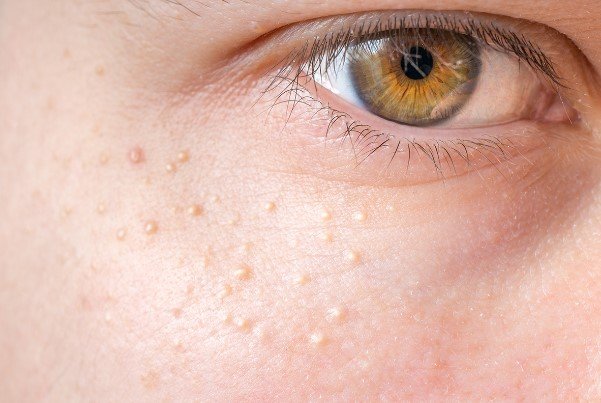Milialar, also known as milk spots or oil seeds, are small, white or yellow bumps that appear on the surface of the skin. They are typically harmless and painless, but some people may find them cosmetically bothersome. Milialar are most commonly seen on the face, around the eyes, cheeks, and nose, but they can also occur on other parts of the body, including the genitals.
What are Milialar?
Milialar are tiny cysts caused by trapped keratin, a protein that forms the outermost layer of your skin. Keratin normally sheds from the skin’s surface, but in the case of Milialar, it gets trapped beneath the skin, forming a small cyst.
There are two main types of Milialar:
- Primary Milialar: These are the most common type and typically appear in newborns and young children. They usually disappear on their own within a few weeks.
- Secondary Milialar: These Milialar develop later in life, often due to sun damage, prolonged use of steroid creams, or blistering skin conditions.
Milialar are not contagious and do not require urgent medical attention. However, if they bother you cosmetically or you suspect they might be something else, consulting a dermatologist is recommended.
Causes of Milialar
The exact cause of Milialar is not fully understood, but several factors can contribute to their development:
- Skin shedding: When the skin’s natural shedding process is disrupted, it can lead to keratin buildup and the formation of Milialar. This is especially common in newborns whose skin is still developing.
- Sun damage: Sun exposure can damage the skin and impair its ability to shed properly, increasing the risk of Milialar.
- Steroid creams: Topical corticosteroids, used to treat various skin conditions like eczema and psoriasis, can sometimes block skin pores and contribute to Milialar formation.
- Blistering skin conditions: Injuries, burns, or blistering skin conditions like pemphigus can damage the skin and lead to secondary Milialar.
- Cosmetic procedures: Certain cosmetic procedures, such as dermabrasion or laser resurfacing, can damage the skin and increase the risk of Milialar formation.
Symptoms of Milialar
Milialar are typically easy to identify by their appearance. Here are some key characteristics:
- Size: Milialar are usually small, ranging from 1 to 2 millimeters in diameter.
- Color: They appear white or yellow in color.
- Location: Milialar are most commonly found on the face, particularly around the eyes, cheeks, and nose. However, they can also occur on the genitals, trunk, and other areas.
- Texture: Milialar feel firm and smooth to the touch.
- Pain: Milialar are generally painless and do not cause any discomfort.
If you notice small bumps on your skin that have the characteristics mentioned above, they are likely Milialar. However, if you are unsure, it’s always best to consult a dermatologist for diagnosis.
Treatment Options for Milialar
Milialar often disappear on their own, especially primary Milialar in newborns. However, if they persist or you want them removed for cosmetic reasons, several treatment options are available. Here are some common approaches:
- Extraction: A dermatologist can use a sterile needle or comedone extractor to carefully remove the contents of the Milialar cyst. This is a quick and effective procedure, but it should only be performed by a qualified professional to minimize the risk of scarring or infection.
- Dermabrasion: This procedure involves using a rotating brush or sandpaper to remove the top layer of skin. It can be effective in removing Milialar, but it also carries some risks, such as scarring and changes in skin pigmentation.
- Microneedling: This minimally invasive procedure involves using a device with tiny needles to create microscopic punctures in the skin. It can stimulate collagen production and improve skin texture, potentially helping to clear Milialar.
- Laser treatment: Certain types of lasers can be used to target and vaporize the Milialar cysts. This is a precise and effective method, but it may be more expensive than other options.
It’s important to note that these treatment options should only be performed by a dermatologist. They will be able to assess your individual situation and recommend the most appropriate course of action.
Preventing Milialar
While there’s no guaranteed way to prevent Milialar, some practices may help reduce the risk:
- Sun protection: Regularly apply sunscreen with an SPF of 30 or higher to protect your skin from sun damage, which can contribute to Milialar formation.
- Gentle exfoliation: Regularly exfoliate your skin with a gentle scrub or wash to remove dead skin cells.
Conclusion
Milialar are small, harmless bumps on the skin caused by trapped keratin. While they are not a cause for major concern, they can be cosmetically bothersome. Understanding the different types of Milialar, their causes, and the available treatment options can empower you to manage this condition effectively.
